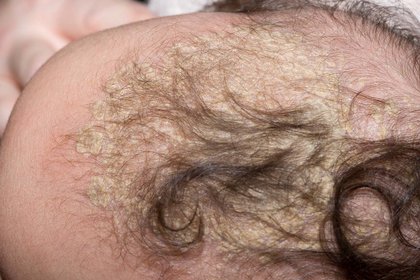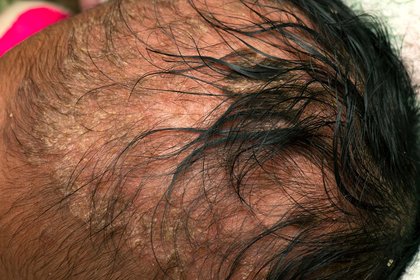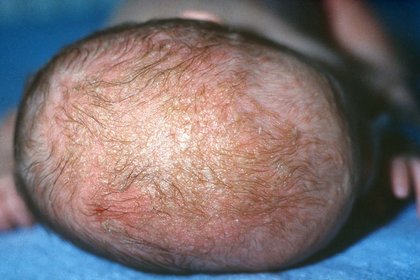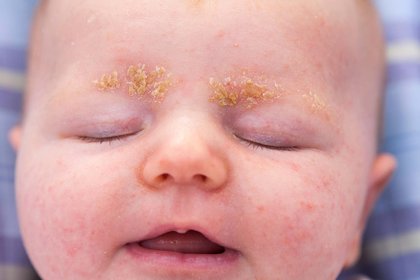Symptoms of cradle cap
The main symptom of cradle cap is patches of greasy, scaly skin.
It's usually found on the scalp and face, but sometimes affects the nappy area. It can look like:
- patches of white or yellow greasy scales on the scalp and face that form a crust which might flake off
- small, dry flakes of skin on the nappy area
The scales look similar on all skin tones. But the skin under the scales may look pink or red if your baby has white skin, or lighter or darker than the surrounding skin if your baby has brown or black skin.
It is not itchy or painful and does not bother your baby.
The cause of cradle cap is not clear, but it cannot be caught from other babies.
- 1: Cradle cap on the scalp of a baby with white skin (thumbnail).
- 2: Cradle cap on the scalp of a baby with medium brown skin (thumbnail).
- 3: Cradle cap on the scalp of a baby with white skin (thumbnail).
- 4: Cradle cap on the eyebrows of a baby with white skin (thumbnail).

Long description, image 1.
Cradle cap on the scalp of a baby with white skin and dark brown hair.
A pale yellow crust covers the top of the head. The crust ends at the hairline, just above the forehead. The crust has many scales of skin, many of which join together. There are no scales on the forehead.

Long description, image 2.
Cradle cap on the scalp of a baby with medium brown skin and black hair.
A large oval area on the top of the head looks pink with many pale brown patches. There are also many pale yellow, flaky scales. At the edge of the patch of cradle cap, closest to the forehead, the scales are close together and form a crust. There's also a crust at the top of the head, with hair covering it.

Long description, image 3.
Cradle cap on the scalp of a baby with white skin and pale brown hair.
An oval-shape patch of cradle cap spreads from the forehead to the top of the head. The skin in this area looks pink with many greasy, pale yellow scales. Most scales are close together, forming a crust, but some scales are further apart.
There's a small, round, darker pink patch of cradle cap on the head, in the lower left part of the image.

Long description, image 4.
Cradle cap on the face of a baby with white skin.
A raised crust of yellow scales covers the inner corners of each eyebrow. The crust is thickest towards the middle of their face. The eyebrow on the right side of the photo has a 2nd, smaller patch of crusty scales at the end.
The forehead and cheeks are covered in many tiny pink spots.
Things you can do to help with cradle cap
Do
-
lightly massage an emollient (moisturiser) on to your baby's scalp to help loosen the scales
-
gently brush your baby's scalp with a soft brush and then wash it with baby shampoo
Don’t
-
do not use olive oil, it may not be suitable for use on skin
-
do not use peanut oil (because of the allergy risk)
-
do not use soap or adult shampoos
-
do not pick crusts because this can increase the chance of infection
Your baby's hair may come away with the scales. Do not worry if this happens as it will soon grow back.
A pharmacist can help with cradle cap
You can ask a pharmacist about:
- an emollient you can use on your baby's scalp
- unperfumed baby shampoos
- barrier creams to use on your baby's nappy area, if it's also affected
Non-urgent advice: See a GP if:
- your baby's cradle cap does not get better after a few weeks of treatment
- your baby has cradle cap all over their body
- the crusts bleed or leak fluid
- the affected areas look swollen
Bleeding, leaking fluid and swelling could be signs of an infection or another condition like atopic eczema or scabies.
Page last reviewed: 21 April 2022
Next review due: 21 April 2025